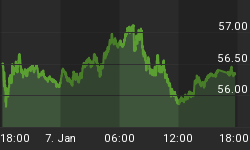Even prior to the new high on 9/11/12, a follower of George Lindsay's Three Peaks and a Domed House model might have been wondering 'could the 3PDh forecast be incorrect?' What would make it incorrect? The three peaks, as labeled in the chart below, meet the requirement of a time span of 6-10 months between peaks one and three. Actually, the distance is not quite six months but is greater than five months. This is seen in many of Lindsay's own examples. The separating decline following peak three fulfills the requirement of reaching a low, lower than either one, or both, of the reactions following peaks one and/or two. On the daily chart one can just make out the five-wave reaction (roman numerals), a First Floor Roof, during November 2011 - another requirement of the pattern. The final reaction took a deep dip which is seen in roughly half of all First Floor Roofs. Finally the pattern between March and May has a rounded top; not a requirement but a typical characteristic of the pattern. The Dow then fell to the area near the First Floor Roof (another characteristic) and until the new high on 9/11/12 had appeared to be engaged in a right shoulder; very common as well.
I expected a top sometime between mid-March and mid-May as this is the time frame outlined by taking 221-day counts from the bottom of both the separating decline on 8/9/11 and the final low of the base on 10/4/11. Once a count of 222 days from the next-to-final low in the base on 9/22/11 matched other short-term counts, it seemed highly probable the top would be found on May 1, 2012. Indeed, a sizeable sell-off occurred there. But counting from the base wasn't correct this time.
Lindsay wrote that a "descending base" implies a long domed house (the 10/4/12 low is the lowest point in the formation). In other words, counting from the base would leave one short of the top of the bull market. In this case, the count is normally taken from one of the inflection points in the First Floor Roof. Taking the longest count (224 days) from the final low in the First Floor Roof on 11/25/12, points to 7/6/12 - nowhere near a high. What if the price action in November wasn't the First Floor Roof? What if the lows on 11/25/11 and 12/19/11 were the "two tests of the low" which Lindsay was adamant about accounting for?
In this case I feel one needs a heavy dose of rationalization to identify a First Floor Roof any higher than the market action in November. But necessity is the mother of invention and we can count five (ascending) reversals between late January and early March.
1/26/12 counts 222 days to the low of 9/4/12.
1/30/12 counts 221 days to 9/7/12.
2/9/12 counts 222 days to 9/18/12.
2/15/12 counts 222 days to 9/24/12.
2/29/12 counts 222 days to 10/8/12.
All the above counts fit a basic long advance (742-830 days) from the 7/2/10 low.
And 3/6/12 counts 222 days to 10/14/12 which is just past the drop-dead date of 10/9/12 - the final date of a long basic advance from 7/2/10.
My point estimate for an end to the bull market, based largely on the 3PDh formation but other models of Lindsay's as well, is for next Tuesday, September 18.

















